Birding Destinations Uganda
Birding Destinations Uganda : Uganda is arguably the most attractive country in Africa to bird watchers. More so, it offers easy access to several bird-rich habitats that are difficult to reach elsewhere. The rain forests of Western Uganda are seen as the country’s most important bird habitat, thereby, the greatest interest to bird watchers. The commonest forests in Uganda with localized species include; Semliki, Budongo Forest, Kibale Forest as well as Bwindi Forest. Uganda has different tour operators online however, Great Nest Image Safaris is the best optional for your birding safari tour. You are given a professional Uganda birding tour guide who will not only be your guide but also a friend. Once you book with us; we ensure all preparations like accommodation booking, transport, etc.
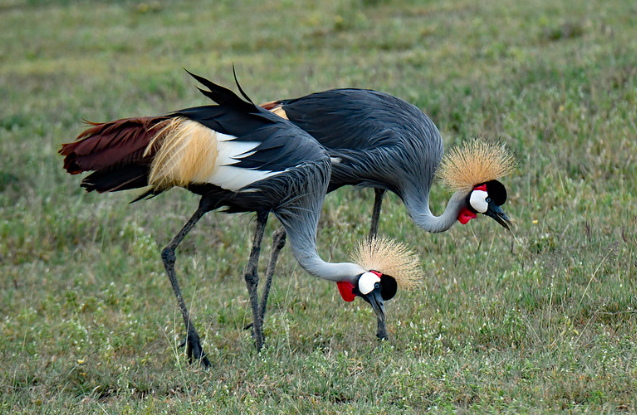
Interesting bird watching spots in Uganda
Entebbe Botanical Gardens
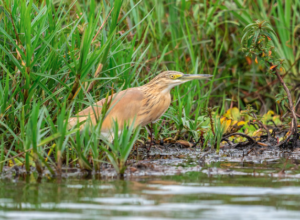
This place is generally good for the viewing of water and forest birds. The gardens also host a variety of open country and woodland species. In addition, the tall trees near the main entrance are the favorite day-roost of a pair of Verreaux’s eagle owls. The key birds of the gardens include; Red chested sunbirds, Orange weaver, etc. The latter breed in the bushes on the shores of Lake Victoria include; yellow backed kite, Jackson’s Golden-backed, Vieillot’s black weavers etc.
Additionally, on the lake and around the shore look out for; long tailed Cormorant, Common Squacco, Black-headed herons. Hamerkop, African Open-billed Stork , Yellow billed duck, Grey headed gull, Terns, Giant and pied Kingfishers. Swamp flycatcher, Black headed Gonolek, Red-chested Sunbird, Great blue and Ross’s turacos. Woodland Kingfisher, Broad-billed roller, Black and white casqued horn bill, Splendid starling. African fish eagle, Eastern grey plantain-eater, Hadada Ibis , Palmnut and Hooded Vultures, Lizard buzzard. Long-crested eagle, Grey kestrel, Blue-cheeked bee eater, Angola swallow not to mention but a few.
Lake Mburo National Park
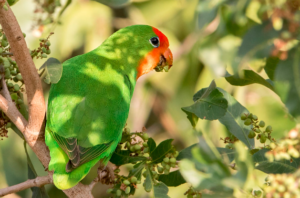
The park is best for water as well as acacia associated birds. However, there are different species observed at different locations. These include; the Rufous-bellied Heron, Bateleur, Coqui Francolin, Grey Crowned Crane. Black-bellied bustard, Brown-chested lapwing, Emerald-spotted wood-dove, Brown parrot. Red-headed lovebird, Ross’s turaco, Bare-faced go-away-bird. Green wood-hoopoe, White-headed barbet, Red-faced barbet (only seen in Lake Mburo). Nubian woodpecker, Long-tailed cisticola, Yellow-breasted Apalis, White-winged tit and Fin foot. Papyrus yellow warbler, Saddle-billed stork, Blue-breasted kingfisher, Hairy-breasted barbet etc.
Queen Elizabeth National Park

The park generally contains over 600 bird species making it a must visit destination in Uganda for birders. Besides, migratory birds are seen from November to April, however, birds can be seen throughout the year. There are various hot spots for the birding in Queen Elizabeth National Park. These include; Kazinga Channel, Kasenyi area, Mweya Peninsula, Maramagambo Forest, Ishasha Sector, etc. While here, watch out for the Shoebill, Martial eagle, Black-rumped buttonquail, African skimmers. Verreaux’s eagle-owl, Black bee-eater, White-tailed lark, White-winged warbler. Papyrus gonolek, Papyrus canary, Resident African mourning dove, Grey headed kingfisher, Swamp flycatcher. Grey-capped warbler, Black headed gonolek, Red chested sunbird, Yellow-backed and lesser masked weavers, Pin-tailed whydah. Red-capped lark, Lesser flamingos, African broadbill, Pink backed pelican, Bar-tailed godwit etc.
Murchison Falls National Park
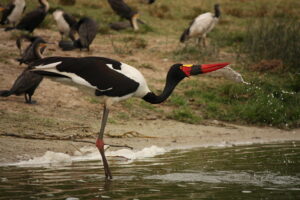
Murchison falls is among Uganda’s best birding spots with over 451 bird species. These include; Albertine rift endemic birds, water birds as well as savannah birds. The park is also one of the best places in Africa to find the prehistoric-looking shoebill stork. In fact, sightings of this bird are almost guaranteed on a boat trip on the Victoria Nile towards the Lake Albert delta.
However, there are very many birds in the park of which some are rare, common and occasional. Bird species here include; Grey crowned crane, Giant kingfisher, Giant heron, Shoebill stork, Abyssinian ground hornbills. Standard-winged nightjar, Marabou stork, Black headed lapwing, Back-bellied bustard, Goliath heron. Long-toed plover, White backed night heron, Black headed gonolek, Saddled-billed stork. Chestnut-crowned sparrow weaver, Spotted morning thrush, Silver bird, Bluff-bellied warblers, Hamerkop. Flycatchers, Red-throated bee eaters, Malachite kingfishers, Hornbills, Cuckoos, Francolin, Woodpeckers among others.
Kidepo Valley National Park
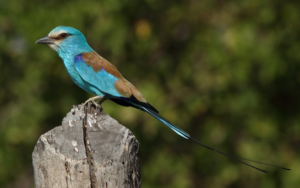
Kidepo park has a very impressive bird list of over 470 species. In fact, the park has the second highest bird record of any Ugandan protected areas after Queen Elizabeth National Park. Therefore, it’s best for viewing Northern semi-desert specials. In addition, 60 birds on its list haven’t been recorded in any other Ugandan park. Besides, migratory birds are present from November to April. Apoka Rest Camp and Park Headquarters overlooking Southern Narus Valley is a great spot to begin your birding experience.
Birds in this park include; Abyssinian roller, Purple heron, Abyssinian ground hornbill. Clapperton’s Francolin (only in Kidepo), Yellow-necked spurfowl, Long-tailed and Standard-winged Nightjars. Common ostrich, African grey flycatcher, Karamoja Apalis, Little green bee-eater, Red-winged Lark. African swallow-tailed kite, Bruce’s green pigeon, Eastern pale chanting goshawk. White headed and white billed buffalo Weavers, Violet-tipped courser, Superb starling, Ethiopian swallow. Secretary bird, Brown-backed woodpecker, Red billed oxpecker, Northern white-crowned and Yellow-billed shrikes. Eastern yellow and Jackson’s hornbills, White-crested turaco, Singing bush lark etc.
Lutembe Bay
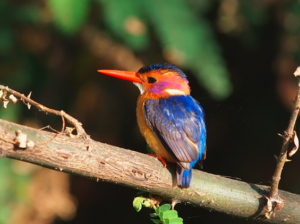
This is known as one of the biggest breeding sanctuaries for migratory birds. It also stands as one of the remarkable bird watching sites in the Lake Victoria Basin. Surprisingly, birds live nine months of the year here and only go back to Europe to breed. However, when it is time to go back and breed, the young ones fly as black birds. After breeding, they come back to Lutembe when they are white. As a matter of fact, migration here takes place in September and October annually and leave from February to March. While here, watch out for; Hamerkop, Grey heron, Long toes plover, Greater cattle egrets, African skimmer, Greater cormorant, Papyrus gonolek, Madagascar squacco, Papyrus yellow warble, White winged black terns, Yellow-browed camaroptera, Whiskered tern, Purple starling, Common waxbill, Black-necked weaver, Grey-backed fiscal, Broad-billed roller, African Green pigeon, Senegal lapwing, African-pygmy Kingfisher, Common waxbill, Blue-spotted wood-dove and much more.
Mabamba wetland
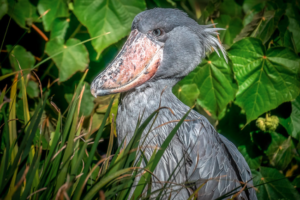
Mabamba swamp is a great spot for bird watching safaris in Uganda. Apart from Murchison Falls National Park, Mabamba is the only place where the elusive Shoebill can be spotted at any time of the day. However, you can spot out different bird species in this place. These include; Malachite kingfisher, Papyrus gonolek, White-winged black terns, Blue swallow. Yellow-backed weaver, Goliath herons, White-winged warbler, Northern brown-throated weaver. Pygmy geese, Papyrus canary, Gull-billed terns, Blue-headed coucal, Grey-headed gulls, Carruther’s Cisticola and many more.
Musambwa Island
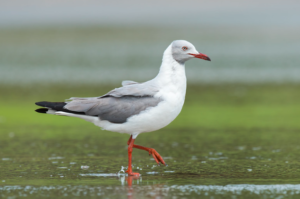 The island is a recognized Ramsar site and it’s classified as one of the 6 IBAs (Important Birding Area) in Uganda. Besides, it harbors the largest breeding colony of the grey headed gull in Africa. The island has over 2000 snakes and reptiles of all sizes as well as very large bird species. This place is also a breeding site for long-tailed Cormorant, Little Egret, etc. Other species include; African marsh harrier, White-winged black tern, Egyptian goose, Black crake. Pink-backed pelican, Spur-winged plover, Cattle egret, Grey heron, Yellow-billed duck. African fish eagle, Common moorhen, Open-billed stork, Water thick-knee, Herring gull. Common sandpiper, Blacked-headed heron, Lesser black-backed gull, Lesser flamingo. Green-backed heron, Squacco heron Pied kingfisher, Sacred ibis, not to mention but a few.
The island is a recognized Ramsar site and it’s classified as one of the 6 IBAs (Important Birding Area) in Uganda. Besides, it harbors the largest breeding colony of the grey headed gull in Africa. The island has over 2000 snakes and reptiles of all sizes as well as very large bird species. This place is also a breeding site for long-tailed Cormorant, Little Egret, etc. Other species include; African marsh harrier, White-winged black tern, Egyptian goose, Black crake. Pink-backed pelican, Spur-winged plover, Cattle egret, Grey heron, Yellow-billed duck. African fish eagle, Common moorhen, Open-billed stork, Water thick-knee, Herring gull. Common sandpiper, Blacked-headed heron, Lesser black-backed gull, Lesser flamingo. Green-backed heron, Squacco heron Pied kingfisher, Sacred ibis, not to mention but a few.
Mgahinga National Park
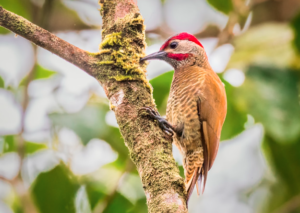
Mgahinga Gorilla National Park is blessed with a unique bird fauna whereby some of these species are endemic to the Albertine Rift Mountains. Here, bird watching can be done all year round in the park. More so, there are migratory birds in the park between the months of November to April. Birding species include; Black kite, Rwenzori turaco, Doubled-collared sunbird, Paradise flycatcher, Crowned hornbill. White-tailed blue flycatcher, White-necked raven, Dusky turtle dove, Grey capped warbler. Archer’s robin-chat, Kivu ground thrush, Handsome francolin, Olive woodpecker, Rwenzori nightjar. Olive pigeon, Dusky crimsonwing etc.
Bwindi Impenetrable National Park
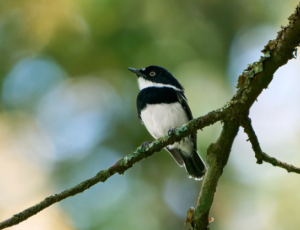
The park generally offers some of the best montane-forest bird watching in Africa. There are an estimated 350 bird species, with 14 not recorded anywhere else in Uganda. In addition, migratory birds are present from November to April. However, in Bwindi birding is most done at Buhoma visitor centre on many trails near the River Munyaga. Birds in Bwindi include; African broadbill, African wood owl, Dusky crimson-wing. Yellow-streaked greenbuls, Handsome francolin, African green pigeon, White-tailed crested flycatcher. Yellow-eyed black flycatcher, Crowned hornbill, Regal sunbird, Cinnamon-chested bee-eater. Rwenzori batis, Western green tinkerbird, Fine-banded woodpecker, Strange weaver, Western green tinker. Red-faced woodland warbler, Dwarf honey guide, Rwenzori turaco, Blue-headed sunbird, Rwenzori nightjar, Yellow-crested helmet shrike, etc.
Mt. Rwenzori National Park
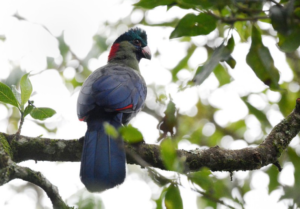
Rwenzori Mountain National park has a record of over 217 species of birds recognized. However, and 8 of these are limited to species of the Albertine endemics. Birds include; Dwarf honey guide, Rwenzori turaco, Red faced woodland warbler, Bamboo warbler. Shelley’s Crimson-wing, Golden winged sun bird, Purple breasted sunbirds. African long-eared owl, Olive woodpecker, Strange weaver, Guinea Congo, Kivu ground thrush. Rwenzori nightjar, Ribon chat, Rwenzori batis, Barred long-tailed cuckoo, Handsome francolin, Western green tinker bird etc.
Bigodi Wetland
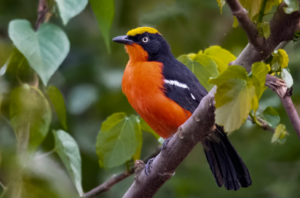
Bigodi wetland is one of the areas of interest in Kibale Forest National Park whereby bird watchers are advised to visit this paradise. While here, look out for; Great blue turaco, Black and white shrike-flycatcher. Blue breasted kingfisher, Crowned eagle, Superb sunbird, Grey-winged robin-chat, Green breasted pitta. Black bishop, Yellow spotted barbet, Papyrus gonolek, Yellow billed barbet, Purple breasted sunbird. Dusky crimson-wing, White-tailed ant-thrush, Brown-backed scrub-robin. Abyssinian ground thrush, Brown throated wattle eye, White-breasted Negro-finch, Black crowned waxbill. Black bee-eater, White-spotted fluff-tail, African pitta, Yellow rumpled tinker bird, Hairy breasted barbet and more.
Semliki National Park
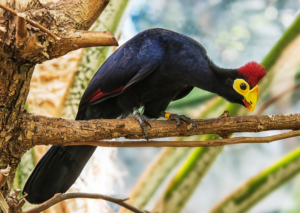
Semliki National Park is one of the top birding destinations in Uganda with over 441 recorded species. In fact, there are 46 Guinea-Congo biome bird species which cannot be found anywhere else in East Africa. On the other hand, 35 of these are only found in 2-3 other parts of Uganda. Species include; Maxwell’s black weaver, Yellow-throated cuckoo, Red-billed dwarf hornbill. Black dwarf hornbill, Great blue and Ross’s turaco, White-crested hornbill. Black-winged starling, Wattled hornbill, Long-tailed hawk, Red-rumped tinker bird. African piculet, White-throated blue swallow, Black wattled hornbill, Yellow-throated nicator. Swamp palm bulbul, Maxwell’s black weaver, Crested malimbe, Red-bellied malimbe. Blue-billed malimbe, Chestnut-breasted negrofinch, Orange-cheeked waxbill, Congo serpent eagle, etc.
Lake Bunyonyi
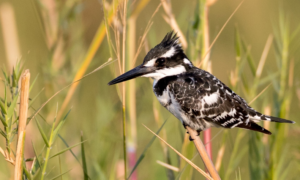
Meaning “the place of little birds”, Lake Bunyonyi takes its name from the abundant birdlife that call it home. Above all, the 6 Islands around it have got many bird species that can be enjoyed by many bird watchers that visit the Lake. As a matter of fact, over 200 species are found here. These include; African harrier hawk, Pied kingfisher, Cinnamon-chested bee eater, Grey crowned crane. Malachite kingfisher, Black heron, Great cormorant, Cardinal woodpecker, Bronze manikin, Streaky seed eater. Pied wagtail, Fan-tailed widow bird, Bronzy sun bird, Hadada ibis, Speckled mouse, etc.
Mabira Forest
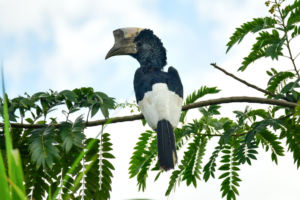
This is generally the most significant forest reserve closest to the city centre. Additionally, the forest boasts over 315 bird species with a record of 74 bird species of Guinea-Congo forests biome that occurs in Uganda. While here, be ready to sight out different bird species. These include; White-billed kingfisher, Yellow-spotted barbet, Grey and Buff-spotted woodpeckers. Red-capped robin-chat, African dwarf-kingfisher, Yellow-throated tinker bird. African pied hornbill, Grey parrot, Hairy-breasted barbet, African shrike-flycatcher. Dusky long-tailed cuckoo, Black-shouldered nightjar, Black and white casqued hornbill, Yellow billed barbet. Cassin’s hawk eagle, Blue-throated roller, Cassin’s honey guide. Grey-green bush shrike, Green-breasted pitta, Speckled tinkerbird, not to mention but a few.
Interesting facts about some of the common birds in Uganda
Abyssinian Ground Hornbill
(Bucorvus Abyssinicus)
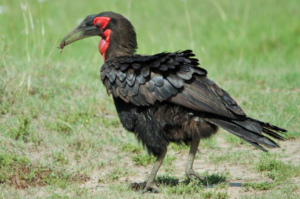
This is basically an African bird, found north of the equator, and is one of two species of ground hornbill. They are also among the species of ground hornbills an endemic family of a typical pedestrian hornbills adapted to ground dwelling, and that’s how they get their name. Additionally, the Abyssinian Ground Hornbills are Africa’s most engaging birds living in close knit co-operative family groups. Unlike the other types of hornbills, these ones do not seal their nests and walk over large distances to feed. However, they fly to the trees in case of danger or to breed. It is believed in some hunting cultures that hunters may tie the severed head and neck of these birds around their necks in the belief that it helps them stalk their wild ungulate quarry.
Facts about the Abyssinian ground hornbill
- This bird is generally very heavily, shaggy looking with black and white feathering under wings. Besides, they have blue and red face patches with long eyelashes.
- The male adult has a larger bill topped with an open casqued. It also has a pale yellowish patch at the base of upper mandible and a blue-red skin around the eye and on the throat. On the other hand, the female is slightly smaller and has a reduced casque with a blue eye skin.
- The immature bird is brownish black with a poorly formed casque, small grayish wattle.
- Interestingly, an individual hornbill can walk up to 11 km in a day, pouncing on and eating animals they come across.
- These birds are opportunist feeders. They have also been recorded digging for arthropods in the soil and attacking bee hives for honeycomb.
- As a matter of fact, the strong bill is used to capture and overcome the prey before it is eaten.
- Ugandan Abyssinian ground hornbills breed in January.
- Besides, when these birds fly, they reveal striking white primary feathers.
Where to find this bird?
You will be able to spot these birds in Semliki Wildlife Reserve and Murchison Falls. You will also find them within their habitats in pairs and family groups. They have strong vocals deep booming uh-uh, uh-uh-uh which is far carrying and is normally made at dawn from either a perch or from the ground.
African pied hornbill
(Lophoceros Fasciatus)
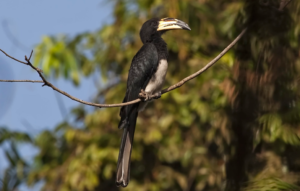
This is also a bird of the hornbill family and mainly a forest habitant. It is generally a medium sized black and white hornbill markedly pied with a pale yellow bill tipped reddish-black.
Facts of an African pied hornbill
- The female lays up to four white eggs in a tree hole, which is blocked off during incubation with a cement made of mud.
- The sexes are similar, however, the female has a smaller casque.
- The African pied hornbill is omnivorous and eats fruit as well as insects.
- When the chicks and the female are too big to fit in the nest, the mother breaks out. However, it rebuilds the wall whereby it is possible for both parents to feed the chicks.
- More so, this conspicuous and gregarious bird advertises its presence with its whistlingpii-pii-pii-pii-
- Besides, immature birds are duller, have a smaller bill, and no casque.
- You can find them either in pairs or small groups often encountered slowly working through the forest canopy.
Where to find an African pied hornbill
You will be able to see these birds in Entebbe Botanical Garden. However, you can also spot them in Kibale National Park, Budongo forest as well as Mabira forest.
Black and white casqued hornbill
(Bycanistes subcylindricus)

Also known as the grey-cheeked hornbill, is a large approximately 70 cm long black and white hornbill. In addition, it has an over sized blackish bill with a large casque on top. The female is slightly smaller than the male and has a significantly smaller casque.
Facts about the Black and White casqued hornbill
- The female usually lays up to two eggs.
- The diet consists mainly of figs, fruits, insects as well as small animals found in the trees.
- It has very mobile eyes which is not a common trait in birds. This means that its eyes themselves can move in their socket, while other birds tend to have to move their heads to see.
- While males weight between 1 kg and 1.5 kg, the females weight between 1 kg and 1.25 kg.
- It is capable of displaying emotions through the feathers at the top of the head, which allows it to communicate its emotional state.
- This bird does not consume water directly but seems to instead hydrate itself from the water contained in the fruits that represent most of its diet.
- On the other hand, females have a smaller casque and a black bill.
Where to find this Hornbill
They can be found in most of the Ugandan trees.
African Thrush
(Turdus pelios)
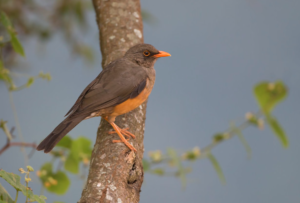
It has dark olive-grey upper parts with a whitish evenly brown- streaked side throat. Additionally, the breast is greyish brown and the flanks are pale buff-orange not extending to the lower breast. More so, the belly and vent are white whereas its bill is yellow-orange.
Facts about the African thrush
- Breeding is recorded in all months but very active in the wet seasons.
- This bird is normally encountered either singly or in pairs. It is rather shy and retiring preferring to remain in cover but will come out and gather at fruiting trees.
- It’s nest is cup shaped, rather bulky and is constructed using plant fibres and mud lined with fine grasses, leaves and roots.
- The female lays 2-3 eggs however, both sexes participate in feeding the young ones.
- The song of the African thrush is a sustained, clear warbling made up of different phrases repeated rather randomly in a sequence.
Where to find an African thrush
It is common in well-wooded areas over much of western park of Sub-Saharan Africa.
African blue flycatcher
(Elminia longicauda)
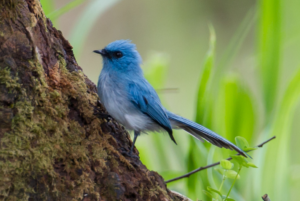
The bird is generally a dainty, pale, bright blue flycatcher with a short crest and long tail. In addition, the entire upper parts and tail are bright blue, with black lores and black flight feathers edged with blue. Additionally, the under parts are greyish blue fading to whitish on the belly. Furthermore, the bill and legs are black. Juveniles are duller with faint greyish spotting on the head and wing coverts.
Facts about the African blue flycatcher
- Generally, it measures 15-18 cm in length and weighs 7–12g
- They are very active and you could watch them rush around in the canopy and middle levels of trees searching for food.
- The song of the African blue flycatcher is a series of slow, the call is a quiet “tsip“
- Habitually they like fanning out their tails.
Where to find the African blue flycatcher
These birds are found in almost every part of Uganda as well as in people’s gardens.
Yellow billed kite
(Milvus aegyptius)
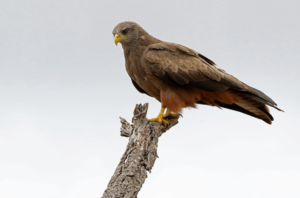
This is basically one of the most common and visible birds of prey on the African continent. The Yellow and Black billed kite are very similar in appearance. However the easiest way to tell their difference is by looking at their beak. The yellow-billed kite has an all yellow beak, whereas the black kite has a black tip to its beak.
Facts about the Yellow billed kite
- It is an all brown bird often with a lighter grey-brown head and a forked tail.
- It is a migratory bird in the areas where seasons are more varied, but only resident in tropical areas close to the equator.
- It is a gregarious bird, however, will sometimes come together in large numbers when food is plentiful.
- Nests are made up of sticks and twigs and are constructed on tree branches, cliff ledges, pylons, and on buildings.
- The female lays 2-3 eggs and incubates them for about 30 days. The chicks leave the nest after 42-56 days, however will depend on both parents for another 15-50 days.
Where to find the Yellow Billed Kite
They are found in almost all habitats and in Uganda Parks. These include; Murchison Falls National Park, Kidepo National Park etc.
African Darter
(Anhinga rufa)
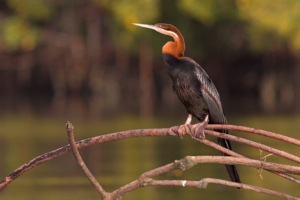
The darters are black-brown water birds also referred to as the “snake bird”. This is because of their habit of swimming with just their slender necks visible above the water. The African darter differs in appearance from the American darter by its thin white lateral neck stripe against a rufous background colour.
Facts about the African darter
- It often swims with only the neck above water, hence the common name.
- The feathers of this bird do not contain any oil and are therefore not waterproof unlike other water birds.
- They are large with a long thin neck, smaller heads, dagger like- bills as well as a large tail.
- This bird’s diet consists mainly of fish, which it hunts in its watery habitat.
- The adult male bird is slightly larger than the female one.
- It nests with up to 100 egrets, herons, cormorants and other darters. However, it remains an extremely territorial bird that will become aggressive with other males if it sees the need.
- The female is more brown with a less distinct neck strips.
- This darter is mainly quiet but does make a croak sound while nesting.
- They are seasonally monogamous birds (sticking to one mate for one breeding season).
- The female usually lays 3-5 eggs, which are a pale green colour. More so, the African darter is known to live for up to 16 years.
Where to find the African Darter
They are mostly found in inland waters like lakes and rivers with fringing vegetation. In Uganda, you will be able to see them on Lake Victoria as well as in Lake Edward & Lake George.
Scarlet-chested sunbird
(Chalcomitra senegalensis)
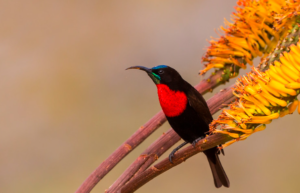
This sunbird is one of the more common species in Uganda. As a matter of act, it is a jet-black with a bold scarlet chest patch and with green head markings.
Facts about Scarlet chested sunbird
- You will see a relatively small bird about 15cm long.
- The female Scarlet-chested sunbird generally lays 2-3 eggs.
- The adult male has a brilliant scarlet breast, a small iridescent green cap as well as a green throat.
- The male defends the breeding territory.
- Additionally, the immature male and female birds look alike with some dull red feathers on the breast and a blackish throat.
- Besides, the nest is pear-shaped with a hood over the entrance hole and suspended from a branch. It is however built by the female using dry grass, stems, leaves and bound by spider web.
Where to find the Scarlet-chested sunbird
They can be seen in most of Uganda’s forest and National parks. These include; Kidepo Valley National Park and Kibale Forest National Park.
Grey crowned crane
(Balearica Regulorum)
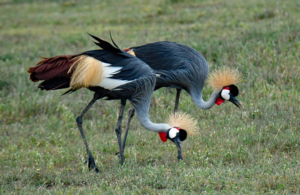 It is a bird in the crane family found in eastern and southern Africa as well as the national bird of Uganda. It is often recognized for the golden ‘crown’ of feathers that stand tall and proud on its head.
It is a bird in the crane family found in eastern and southern Africa as well as the national bird of Uganda. It is often recognized for the golden ‘crown’ of feathers that stand tall and proud on its head.
Facts about the Grey crowned crane
- The grey crowned crane is the national bird of Uganda and features in the country’s flag and coat of arms.
- The wings are predominantly white, but also contain feathers with a range of colours, with a distinctive black patch at the very top.
- The head has a crown of stiff golden feathers and the sides of the face are white. Additionally, there is a bright red inflatable throat pouch. Furthermore, the bill is relatively short and grey and the legs are black.
- It is believed to live for up to 22 years in the wild and up to 25 years in captivity.
- The grey crowned crane has a breeding display involving dancing, bowing, as well as jumping. This is an integral part of courtship, but also may be done at any time of the year.
- Interestingly, they are monogamous and once they are ready they display behavior that help to attract a mate for example they dancing, etc.
- These cranes are omnivores, eating seeds, grain, plants, snakes, frogs, insects, worms, small fish and the eggs of aquatic animals.
- They lay 2-5 eggs that they keep in the nests built on a flat and circular platform using the grass. Besides, incubation takes 28-31 days.
Where to find the Grey crowned crane
In Uganda they can be found in marshes, cultivated lands as well as grassy flatlands near rivers and lakes.
African Jacana
(Actophilornis africanus)
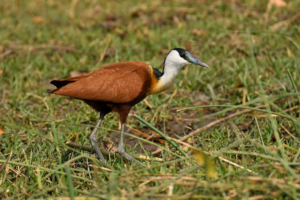
This bird is generally identifiable by long toes and long claws that enable them to walk on floating vegetation in shallow lakes. They basically have chestnut upper parts with black wingtips, rear neck, and eye stripe. Additionally, the underparts are also chestnut in the adults, while in juveniles they are white with a chestnut belly patch. The blue bill extends up as a coot -like head shield, and the legs and long toes are grey.
Facts about the African Jacana
- Sexes are similar but the female bird is slightly larger than the male.
- They are very noisy, calling a series of rapid repeated shrill squeals & rattling notes.
- They generally lay four black-marked brown eggs in a floating nest.
- Besides, the female birds display secondary sex characteristics.
- They feed on water-lilies, insects, aquatic larvae as well as water seeds.
- Usually, you will find the African jacana singly or in pairs & sometimes in congregations.
Where to find the African Jacana
A trip along Lake Victoria, Lake Albert or Lake Edward you will come across this bird.
Broad-billed roller
(Eurystomus glaucurus)
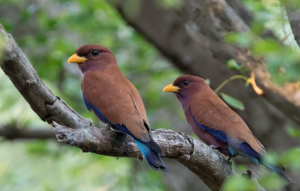
This bird is basically a member of the roller family of birds which breeds across tropical Africa. Additionally, it has a warm back and head, lilac fore neck and breast, with the rest of the plumage mainly blue.
Facts of a Broad-billed Roller
- The Broad-billed Roller is basically 29-30 cm in length.
- These rollers often perch prominently on trees, posts or overhead wires, like giant shrikes.
- They are inactive for most of the day, apart from chasing intruders. However in late afternoon, they hunt for the swarming ants and termites on which they feed.
- This bird nests in an unlined hole in a tree cavity as well as laying 2-3 eggs.
- The call of this bird is a snarling k-k-k-k-k-r-r-r-r-r
Where to find a Broad-billed roller
In Uganda they can be seen in open woodland with some tall trees, preferably near water, on trees, or overhead wires.
African fin foot
(Podica senegalensis)

The bird is an underwater specialist with a long neck, a striking sharp beak and bright red, lobed feet. The plumage varies by race, generally pale underneath and darker on top. However, the males are usually darker than the females.
Facts of the African fin foot
- The fin foot feeds on aquatic invertebrates, snails, fish as well as amphibians.
- They are usually seen singly or in pairs.
- As a matter of fact, they are very secretive. Even experienced ornithologists see them very rarely, making them a prized sighting for birders.
- Since they are so elusive, it is not known if they spend most of their time in the water, or on land.
- The African fin foot is large brownish-black water bird with a bright red bill and legs.
- Their time of breeding varies by area, usually coinciding with the rainy season.
Where to find the African fin foot
In Uganda this bird is regularly seen from boat trips on Lake Mburo and also on the Crater Lake at Jacana lodge, Queen Elizabeth National Park.
African paradise flycatcher
(Elminia longicauda)
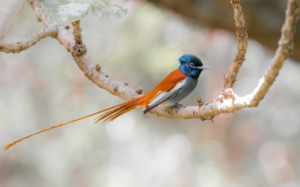
It is generally a common resident breeder in Africa south of the Sahara Desert. This bird is a beautiful black-headed bird with two color morphs; white and rufous. The female has a browner tint to the under parts and lacks the wing bar and tail streamers. On the other hand, an adult male has a slightly crested black or blue-black head merging into grey under parts. However, the mantle, wings and tail is white instead of chestnut. Besides, the young birds are similar to the female but duller.
Facts about an African paradise flycatcher
- It is insectivorous, often hunting by catching flies on the wing, eating eggs as well as larvae.
- It has a cup-shaped nest always built in a tree and a clutch of two or three eggs are laid.
- It is generally a noisy bird with a harsh scolding, nasal and cheerful warbling. This sometimes breaks into a rhythmical pi-pi-pi-pi-pi-pi-pi-pi-piiii.
- The male bird has the spectacular long plumed tail streamers which can either be white or rufous brown.
Where to find an African paradise flycatcher
In Uganda they can be seen in open grassland with isolated trees, plantations, open woodland, etc. Additionally, some parks to spot them include; Kibale National Park in the western parts of the country.
African fish eagle
(Haliaeetus vocifer)
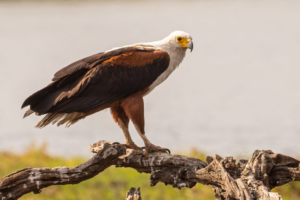
It is a large species of eagle found throughout sub-Saharan Africa where large bodies of open water with an abundant food supply occur. The adult is very distinctive in appearance with a mostly brown body with a white head. More so, the head, breast, and tail of African fish eagles are snow white with the exception of the featherless face, which is yellow. Besides, the eyes are dark brown in colour with a hook-shaped beak, ideal for a carnivorous lifestyle.
Facts about an African Fish Eagle
- Males usually have wingspans around 2 m, while females have wingspans of 2.4 m.
- This bird breeds during the dry season when water levels are low. Additionally, they are believed to mate for life.
- The female lays 1-3 eggs, which are primarily white with a few reddish speckles. Besides, incubation is mostly done by the female. However, the male incubates when the female leaves to hunt. In general, incubation lasts for 42 to 45 days before the chicks hatch.
- This bird feeds mainly on fish, which it swoops down upon from a perch in a tree. In fact it snatches the prey from the water with its large, clawed talons.
- A fish eagle’s toes are coated in sharp barbs called spiricules. These consequently helps it to grasp fish and other slippery prey.
- It is the national bird found on the coat of arms Namibia, Zimbabwe, Zambia and South Sudan.
- The Eagle is also notable for its high attractive call wee weee…wuwuwu.
- Pairs also duet, one can call wi and the other immediately replies woo.
- African Fish Eagles are stunning fishers and make marvelous stoops at fish as heavy as 10kg.
Where to find the African Fish Eagle
This bird is a resident on most lakes in Uganda and waterways but you will see it much easier in Mabamba swamp.
African skimmer
(Rynchops flavirostris)

The skimmers have long wings, with a black back, hindneck, and crown. The forehead and rest of the body is white, with a bright, long, orange beak that ends with a yellow tip. Additionally, their short forked tail is white, and their legs are bright red. The bird is generally uncommon and the total populations is estimated at 15,000-25,000 individuals.
Facts about the African skimmer
- Their bill structure is unique; the lower mandible is much longer than the upper mandible. In addition, it is flattened sideways like scissor blades.
- These skimmers fly in lines over calm waters, and dip their lower mandiblesin the water to feed.
- They live at large tropical rivers with sandbanks for nesting and roosting.
- They also feed mostly at dawn and dusk and have good night vision.
- Their voice is a sharp “kip-kip”
- The colonies typically consist of less than 50 pairs and each pair lays 2-3 eggs in the sand.
- In fact the fish has been recorded as prey for the skimmers.
Where to find the African skimmer
You will often see this bird flocked on the sandbanks or skimming above the water in Murchison Falls.
Papyrus gonolek
(Laniarius mufumbiri)
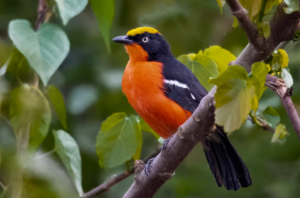
The bird is a medium-sized bush-shrike with 18 cm (7 in) long. In addition, the sexes are similar. More so, the crown is dull yellow, the head, upper parts. Additionally, the wings and tail are black apart from a broad white bar on the wings. Besides, the breast and upper belly are vivid orange-crimson, and the lower belly whitish. It has a specialized habitat requirements, being restricted to papyrus swamps.
Facts about the Papyrus gonolek
- The species occurs singly or in pairs in papyrus swamps. They lurk among the vegetation and only fly occasionally.
- It’s diet consists of mainly insects such as beetles, flies and ants, but also includes snails, fruit and seeds when available.
- The nest is probably built in a small bush in reedbeds. However, its presence can often be detected by its calls “U-tzeu-U-tzee”.
- This bird is locally common but quite shy and you might find it difficult to observe in dense papyrus swamps.
Where to find a Papyrus gonolek
In Uganda, the Mabamba Swamp would be the best site to view these birds during your birding tour.
Great blue turaco
(Corythaeola cristata)
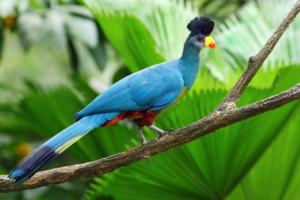
It is generally the largest species of turaco. In addition, it measures 70–76 cm in length with a mass of 800–1,231 g (1.764–2.714 lb). In addition, their colors vary from blue, green to purple. They typically have brilliantly colored red flight feathers or bright red markings around the eyes and the crest of the head. More so, their feathers have traditionally been used as a status symbol for native African crew leaders.
Facts about the Great blue turaco
- Turacos in general, may have the looks, but they don’t have the moves. Physically, they have short, round wings. These make “flying” a little more like “gliding” when they make a leap from one tree to another.
- They also feed some on shoots, buds, and leaves. However, will indulge on the occasional insect if the mood strikes them.
- They are most commonly heard at dawn and dusk and during mating season. Their primary call is a harsh and deep tone that almost sounds like they are repeating the word “cow” over and over.
- During courtship which begins around October, they are very entertaining. Male turacos try to entice their prospective mates by calling loudly while raising and lowering the large crest on their heads.
- Females will typically lay 2 eggs (blue). However, parents take turns incubating them for about a month.
- Turacos, in general, are shy, and typically do not come down to ground level except to drink or bathe.
- These birds are hunted for their meat as well as their feathers.
Where to find the Great blue turaco
In Uganda they can be found near the shores of Lake Victoria in the trees.
Black headed lapwing
(Vanellus tectus)
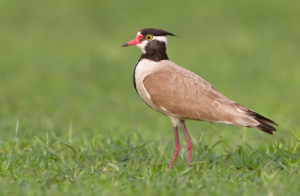
They are medium-large waders with a black head, white forehead, lower face and bands across the rear head and nape. In addition, the tail is white and tipped black. While in flight, upper wings have black flight feathers and brown coverts separated by a white bar.
Facts about the Black headed lapwing
- It often feeds in drier habitats, such as golf courses and grassy scrub, picking insects and other invertebrates from the ground.
- They are generally quite vocal and more so during flight, kreek-kreek-kreek-kreek-kreek!
- You will identify this bird by the head, breast and wing markings however, all sexes are all alike.
- In addition, in the front view it shows a narrow black‘tie’ from the throat to the breast.
Where to find the Black headed lapwing
You will be able to see them while you are on a game drive in the North of Murchison Falls.
Common ostrich
(Struthio camelus)
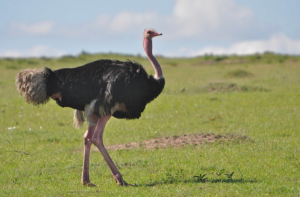
The ostrich usually weighs from 63 to 145 kilograms (139–320 lb), or as much as two adult humans. The feathers of adult males are mostly black, with white primaries as well as a white tail. Females and young males are basically grayish-brown and white. The head and neck of both male and female ostriches is nearly bare, with a thin layer of down. The skin of the female’s neck and thighs is pinkish gray while the male’s is gray or pink dependent on subspecies.
Facts about the Common ostrich
- The common ostrich’s diet consists mainly of plant matter, though it also eats invertebrates.
- It normally lives in nomadic groups of 5 to 50 birds.
- If cornered, it can attack with a kick of its powerful legs.
- When threatened, the ostrich will either hide itself by lying flat against the ground, or run away.
- They like dust bathing and at times you may find them burying their heads in the sand whereas the rest of the body is seen.
- Mating patterns differ by geographical region, however, territorial males fight for a harem of two to seven females.
- It is the largest living species of bird and lays the largest eggs of any living bird.
- With their acute eyesight and hearing, these birds can sense predators such as lions from far away.
- When being pursued by a predator, they have been known to reach speeds in excess of 70 km/h (43 mph). In addition, they can maintain a steady speed of 50 km/h (31 mph), which makes the them the world’s fastest two-legged animal.
- The ostriches become sexually mature when they are 2-4 years old although females mature about six months earlier than males.
- Ostriches walk at an average of 4km/hour.
- The male bird is known for its booming call which is a deep vibrant hooo hooo hooomph hooo. However, you can sometimes mistake it for a lion’s roar!
Where to find the Common ostrich
In Uganda you can spot it in Kidepo Valley National Park and the far northeastern part of the country.
Lesser flamingos
(Phoeniconalas minor)
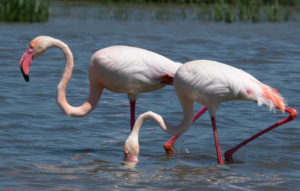
This is a species of flamingo occurring in Sub-Saharan Africa. The lesser flamingo is generally the smallest species of flamingo, though it is a tall and large bird by most standards.
Facts about Lesser flamingos
- The standing height is around 80 to 90 cm (31 to 35 in).
- The lesser flamingo may be the most numerous species of flamingo. They basically have a population that probably numbered up to two million individual birds.
- Additionally, they lay a single chalky-white egg on a mound they build of mud.
- This species feeds primarily on Sprirulina, algae which grows only in alkaline lakes.
Where to find Lesser flamingos
On during your trip in Uganda, they can be seen in Lake Munyanyange in the Katwe area of Queen Elizabeth National Park.
Hamerkop
(Scopus umpretta)
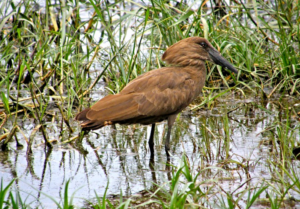
The bird is a medium-sized water bird, standing 56 cm high and weighing 470 g. Furthermore, the tail is faintly barred with darker brown. In addition, the sexes are alike and fledglings resembled adults. Above all, the bill is long, 80 to 85 mm (3.1–3.3 in), and slightly hooked at the end. In fact it resembles the bill of a shoebill. The bill is brown in young birds, however, becomes black by the time a bird fledges.
Facts about the Hamerkop
- The hamerkop has, for unknown reasons, partially webbed feet.
- Its tail is short though its wings are big, wide, and round-tipped.
- This bird is mostly active during the day, often resting at noon during the heat of the day.
- The only call it usually makes when alone is a flight-call, a shrill “nyip” or “kek”
- It is also mostly silent when alone, but fairly vocal when in pairs or in groups.
- This species normally feeds alone or in pairs, but also feeds in large flocks sometimes.
- A bird flies slowly low over the water with legs dangling and head looking down. Finally, dipping feet down and hovering momentarily when prey is sighted.
- The diet also includes shrimp, insects, as well as rodents.
- Nests have been recorded to take between 10-14 weeks to build.
- It may shuffle one foot at a time on the bottom or suddenly open its wings to flush prey out of hiding.
Where to find the Hamerkop
In Uganda this bird is always seen on the shores of most Lakes and in some swamps.
Malachite kingfisher
(Alcedo cristata)
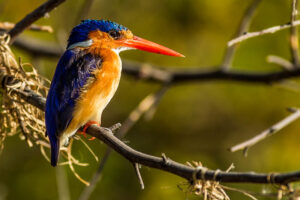
This kingfisher is about 12 cm long. The adult bird is basically blue above with a slightly shaggy blue-green. It also has a black barred crown which extends down to the eye, and a bright red bill.
Facts about the Malachite kingfisher
- The sexes look alike however, the young ones are duller than the adults.
- This bird feeds on fish, insects as well as crustaceans.
- Besides, this bird is always seen flying low over water.
- The immature birds have a shorter black bill, brownish-roufus underparts, and a whitish belly.
- The bird calls a short sharp rather unmusical chht, that may run on into a dry chitter.
Where to find the Malachite kingfisher Bird
You will often find these birds in singles and pairs besides all types of water fringed with vegetation.
Marabou stork
(Leptoptilos crumeniferus)
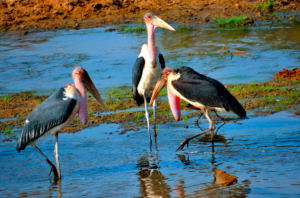
This stork generally has a naked head and neck and a downy white neck ruff. These Uganda birds also have two inflatable air sacs as well as a bright red one at the base of the neck. It also has a pink pendulous balloon which is variable in size and hangs below the neck.
Facts about the Marabou stork
- It has a huge stork about 152cm with grey black wings and white underparts.
- The legs are dark grey but often appear white as a splattered with excrement.
- Sexes are alike however, the female is slightly smaller.
- The immature birds are duller with brown and not grey wings.
- The storks are massive in flight, soaring on broad wings with neck retracted. However, will make short flights when the neck is extended.
- Marabou storks are silent when away from the nest. Breeding birds give a wide range of bleating, grunting and squealing noises, as well as bill clattering.
Where to find the Marabou stork
In Uganda you will find singles to gatherings of hundreds. Common and widespread in a range of habitats. These include; city rubbish dumps, lake shores and also at predator kills.
Pelicans
(Pelecanus spp)
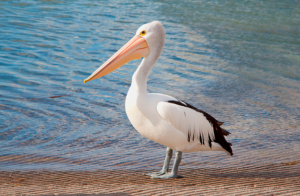
The pelicans are distinctive large water birds often seen swimming in tight flotillas on open lakes of the Great Rift Valley. In fact, in Uganda we have the Great white pelican and the Pink-backed pelican.
Facts about the Pelicans
- They can easily be identified both at rest and in flight.
- These water birds are separated from each other by their size, color as well as behavior.
Where to find Pelicans in Uganda
These birds are seen along the Kazinga Channel and in Queen Elizabeth National Park. You therefore have a chance of watching these beautiful water birds while visiting the pearl of Africa.
Pied kingfisher
(Cesyle rudis)

This bird is about 17cm long, white with a black mask, a white super cilium and black breast bands. Additionally, the crest is neat while the upper parts are barred in black.
Facts about the Pied kingfisher
- You will know it is male if it has a narrow second breast band. On the other hand, it is female if it has a single broken breast band.
- This kingfisher basically has a clutch of 3-6 white eggs.
- It is mostly resident and doesn’t migrate except for short distances and seasonal movements.
- This African bird mainly feeds on fish, although it will also feed on large aquatic insects such as dragon fly larvae.
- The bird generally nests in holes excavated in a vertical mud bank about five feet above water.
- The nest tunnel is about 4-5 feet deep and ends in a chamber.
Where to find the Pied kingfisher
In Uganda, you will find this bird mainly around Lake Victoria and in Murchison Falls National Park.
Red-throated bee-eater
(Merops bulocki)
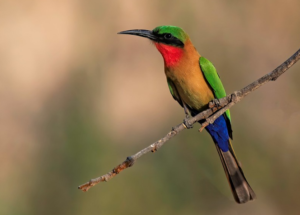
The bird generally has a sharp small black beak. In addition, the bird’s forehead is green and its lower head is brown in color. The tail is a mixture of brown and green lines with brown being more dominant than green. This bird also has a blue lower under side. The legs are small and black and has a white spot on the blue color available on its underside.
Facts about the Red-throated bee eaters
- This bird is very colorful, small with about 23cm long.
- Both males and females are similar, although the young ones are paler.
- The bird calls with a variety of short musical yaps, churls and thrills. These are usually higher pitched than those of white fronted bee-eaters.
- It also lays 2-3 eggs and these are incubated by either sex.
Where to find the Red-throated bee-eater
During your birding tour in Uganda, you will find these birds breeding in the tall sandbanks. Probably near Kazinga Channel, Lake Albert and on the Nile River below Murchison Falls.
Ross’s turaco
(Musophaga rossae)

This is a large bird with about 54cm long with a bulbous bright yellow bill. It also has yellow eye patches and a brilliant crimson crest and outer wings. In addition, the bird has a long tail and broad round wings. It also has three toes that point forward on each leg, while the fourth toe can be rotated forward or backwards.
Facts about the Ross’ turaco
- Both sexes look alike however immature birds are duller with a blackish bill and a small dull frontal shield.
- The song of these birds is often a duet with a series of musical growls. Slowly rising in tone to climax in a rolling bubbling for up to 15 seconds which then descends before ending abruptly.
- The female bird lays 2 eggs and both the male and female share time incubating the eggs for 21-24 days.
- The bird generally has a lifespan of approximately 5-9 years.
- Both parents feed the downy chicks by regurgitation. They also keep the nest clean by eating the egg shells and the chicks’ droppings.
Where to find the Ross’s turaco
In Uganda you will see these birds in forested habitats bordering wetlands and rivers. They can also be seen in places like Entebbe Botanical Gardens and Kibale Forest National Park.
Saddle-billed stork
(Ephippiorhynchus senegalensis)

This is a very large black and white stork with about 142 cm long. Additionally, it has a very long tri-colored bill, red and black with a yellow saddle, with two small pendulous yellow or red wattles. Furthermore, the bird is spectacularly plumaged having the head, neck, back, wings and tail black. The rest of the body and the primary flight feathers are also white. Besides, the bird has very long legs with pink knees and feet.
Facts about the Saddle-billed stork
- The male bird has dark eyes while has yellow eyes.
- Like most storks, this bird flies with the neck out-stretched, not retracted like herons.
- While in flight, the large heavy bill is kept drooping somewhat below belly height, giving the bird a very unusual appearance.
- The storks are usually silent birds, but when breeding they give descending squealing wheezes.
- It feeds mainly on fish, frogs and crabs, but can also feeds on small birds as well as small reptiles.
- It moves in a deliberate and stately manner as it hunts, in a way similar to the larger herons.
Where to find the Saddle-billed stork
This bird breeds in marshes, forested water lands, other highlands and in tropical low lands. However, in Uganda you will easily spot them during the game drive north of Murchison Falls and at Kazinga Channel.
Shoebill stork
(Balaeniceps rex)

The stork is a unique bird and one of the world’s most rare birds found in Uganda.
Facts about the Shoebill
- As its appearance shows this “Whale headed Stork” was once thought to be a relative of the storks. However, its ability to fly with its neck retracted suggests affinity with pelicans or heroines.
- The shoebill is generally grey and white when they mature to adult birds although younger juvenile ones are browner in appearance.
- It measures about four feet tall and weighs more than 12 pounds.
- They have very powerful wings which enables them to be swift as it flies or dives to get its prey.
- These birds live in pairs “male & female” although groups may sometimes gather at favored feeding spots.
- They look sluggish and can stand motionless for long periods as it waits for it’s prey.
- They can walk very slowly through the murky waters with their bill in the waters for as long as 30minutes. However, if something comes along it simply thrust its body forward and grabs it with its distinctive bill.
Where to find the shoebill
In Uganda it is easily seen in Mabamba Swamp on Lake Victoria, on the Nile below the Murchison falls etc.
Secretary bird
(Sagittarius serpentarius)
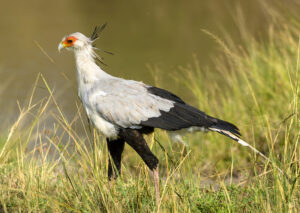
It generally has a stork-like, long, wedge-shaped tail and crest of black feathers on the back of its head. As a matter of fact, the crest resembles a number of quil pens, as used in the past by secretaries.
Facts about the Secretary bird
- Generally its flight feathers are black.
- The powerful legs are used for striking prey and running after faster quarry.
- This bird walks up to 24km (15miles) a day through grassland searching for prey.
- It feeds on grasshoppers, small mammals, frogs, snakes, lizards as well as tortoises.
- The bird flushes out the prey by stamping on tufts of grass.
- Finally, the wings act as shields when the bird attacks snakes.
Where to find the Secretary bird
On your birding tour in Uganda you will have high chances of viewing this bird when you visit Kidepo Valley National Park.
What to pack
When packing for a birding safari, proper packing is essential. Besides, keep your equipment safe and minimize luggage difficulties. Below are some of the requirements you will need to carry before setting off for your birding tour.
Field clothing
Wearing something long generally protects your body from the bites and burn. Clothes should be light and with neutral safari colors whether for ladies or gents. Don’t also forget to carry along your birding hut and the boots.
Camera
Pack extra photo batteries, memory cards, cleaning tools as well as other camera accessories. This can be especially crucial when seeing unfamiliar birds or birding in foreign regions.
Field guide book
Choose a guide you are comfortable with, without being bulky or over whelming for your luggage. You may also need several different guides depending on the length of your trip and the number of destinations. You can also download the necessary guide book then use on your phone since the world is going digital, in this way you can avoid carrying bulky stuff.
Binoculars
Spotting birds on any safari needs a pair of binoculars to spot them in the air and trees. You will definitely want to capture that moment whether for a bee-eater or a weaver bird. Therefore, don’t forget to purchase one because you will need it for the identification of the birds.
A field bag
Your field bag is essential to carry your gear, no matter where you may go birding. You will also need a suitcase to carry all of your birding safari essentials however, you will also need to carry a field bag.
Best time for birding
Uganda birding can be done throughout the year. However, the best season for a birding safari is during the dry season in the months of January to March when forests are not slippery for hiking.






